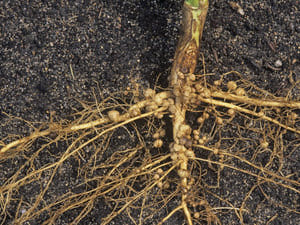| Edible Uses |
Edible Parts: Root.
Edible Uses: Sweetener.
The fibrous root is used as a sweetener for foods[183]. It is boiled in water to extract the sugars etc and used as a liquorice substitute in sweets, medicines, drinks etc[74, 174, 177]. The root contains glycyrrhizin, which is 50 times sweeter than sugar[218]. |
|
| |
| Medicinal Uses |
Plants For A Future can not take any responsibility for any adverse effects from the use of plants. Always seek advice from a professional before using a plant medicinally.
Antiphlogistic; Antispasmodic; Antitussive; Cholagogue; Emollient; Expectorant.
Gan Cao is commonly used in Chinese herbalism, where it is considered to be one of the 50 fundamental herbs[218]. It is considered to be second in importance only to Ginseng (Panax spp)[218]. Used in excess, however, it can cause cardiac dysfunction and severe hypertension[218]. The root is a sweet tonic herb that stimulates the corticosteroidal hormones, neutralizes toxins and balances blood sugar levels[238]. It is also antibacterial, anti-inflammatory, antiphlogistic, antispasmodic, antitussive, cholagogue, demulcent, emollient, expectorant and laxative[61, 176, 218, 238]. It is used internally in the treatment of Addison's disease, asthma, coughs and peptic ulcers[238]. Externally, it is used to treat acne, boils and sore throats[238]. It is included in almost all Chinese herbal formulae, where it is said to harmonize and direct the effects of the various ingredients[238]. It precipitates many compounds and is therefore considered to be unsuitable for use with some herbs such as Daphne genkwa, Euphorbia pekinensis and Corydalis solida[238]. It increases the toxicity of some compounds such as ephedrine, salicylates, adrenaline and cortisone[238]. It should not be prescribed for pregnant women or for people with high blood pressure, kidney disease or anyone taking digoxin-based medications[238]. Excessive doses cause water retention and high blood pressure[238]. It can cause impotence in some people[238]. The roots are harvested in early autumn, preferably from plants 3- 4 years old, and is dried for later use[238]. The flowers are alterative and expectorant[218]. |
|
| Other Uses |
Fire retardant; Insulation.
Liquorice root, after the medicinal and flavouring compounds have been removed, is used in fire extinguishing agents, to insulate fibreboards and as a compost for growing mushrooms[218]. |
|
| Cultivation details |
| Requires a deep well cultivated fertile moisture-retentive soil for good root production[200]. Prefers a sandy soil with abundant moisture[238]. Slightly alkaline conditions produce the best plants[238]. Plants are hardy to at least -15°c[238]. This species is widely cultivated in China as a medicinal plant. Unless seed is required, the plant is usually prevented from flowering so that it puts more energy into producing good quality roots[238]. A very deep-rooted plant, it can be difficult to eradicate once it is established[238]. This species has a symbiotic relationship with certain soil bacteria, these bacteria form nodules on the roots and fix atmospheric nitrogen. Some of this nitrogen is utilized by the growing plant but some can also be used by other plants growing nearby[200]. |
|
| Propagation |
| Pre-soak the seed for 24 hours in warm water and then sow spring or autumn in a greenhouse[200]. Prick out the seedlings into individual pots when they are large enough to handle, and grow them on for their first winter in a greenhouse. Plant out in late spring or early summer when in active growth. Plants are rather slow to grow from seed[238]. Division of the root in spring or autumn. Each division must have at least one growth bud. Autumn divisions can either be replanted immediately or stored in clamps until the spring and then be planted out[200]. It is best to pt up the smaller divisions and grow them on in a cold frame until they are established before planting them out in the spring or summer. |
|





